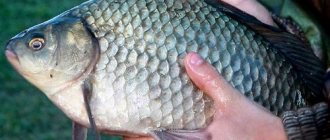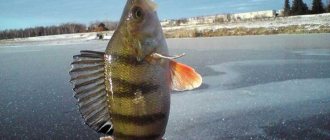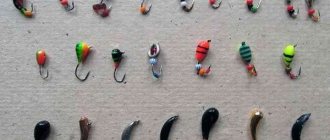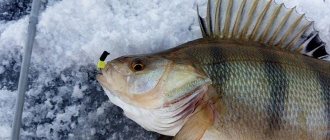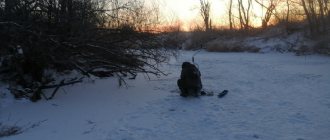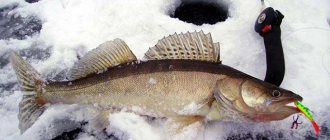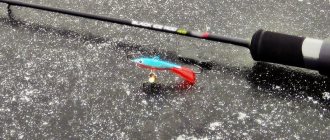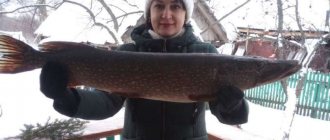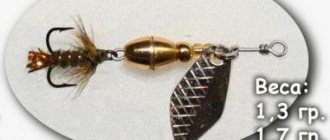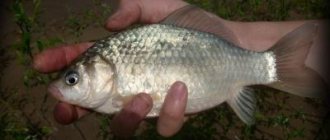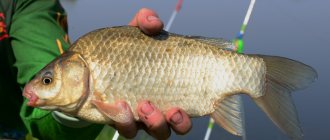With the onset of winter, crucian carp, contrary to the opinion of many fishermen, still continues to be caught; the peak of its activity, like that of other fish species, occurs precisely during the period of first ice. But, in order to achieve the desired result, it is important to know some of the subtleties of this fishing, which we will talk about.
First of all, you should focus on the bait, since crucian carp at this time stays in the bottom layers of water, the bait should be no higher than 20-30 cm from the bottom. The best results are observed when fishing with bloodworms, worms and maggots. You can also use dough.
The fisherman often has to determine the most suitable time for catching crucian carp on the first ice himself, by experience, since there are often cases when crucian carp in some reservoirs are best caught in the daytime, while in others its greatest activity is noted in the evening.
Moreover, daytime crucian carp practically does not react to bait, but as for evening fishing, sometimes you cannot do without it. Therefore, the constant attributes of winter fishing here will be small food bloodworms and cake. However, do not forget that bait should be used in minimal quantities.
Preparation
Before preparing to fish for crucian carp, you need to determine whether it is in a particular body of water. This can be done through word of mouth or through special forums. But even if fishing goes well in the summer, this does not mean that everything will be just as successful on the first ice. The fact is that when the water temperature drops, the fish will try to burrow into the silt, but this will not be possible if the layer is insufficient or, especially, the bottom is hard; in reservoirs that fall under the latter characteristics, the bite will continue all winter.
The crucian carp will be found mainly at depth, so you will have to look for it in holes or in snags. When it warms up, it will rise and go into shallow water. In the southern regions, with constant changes of ice to open water, it will be possible to catch it in the same way as in the fall, in the reeds and at the border of vegetation and open water.
Fishing in a pond works better than in other bodies of water, but preferably at a depth (no more than 4 m). You need to find such holes in the summer. You will have to be quiet, especially if the fish gets closer to shallow water. On ponds and lakes with a large layer of silt, fish will not be caught; such reservoirs can be identified by the abundant vegetation along the banks (bushes, trees), where active fishing occurs before the spring gathering. Crucian carp behave very energetically in reservoirs where warm water is discharged; there they bite regardless of the time of year.
The water temperature there is higher, as is the oxygen saturation.
Lakes are selected with a sandy or clay bottom. In such places it feeds all winter. Found mainly in pits. It looks for food in the same places, so with proper feeding, the flock can be easily lured to a certain territory.
We recommend that you read additionally:
You should choose small rivers with a calm flow. In deeper waters, fishing can also be active, but finding fish there is more problematic due to the vastness of the territory. It is worth looking in creeks where there is practically no current. In large ones, it is worth looking for the confluence of streams; parking lots are mainly located there due to the large influx of oxygen. The choice of location occurs in the same way as in ponds and lakes: at the edges of reed thickets, in windows of vegetation, at depth in snags.
Weather and time of day
There is no single recipe for the weather for crucian carp - we rely on local patterns and characteristics of the reservoir. All these cool calendars are a myth and fiction. On some reservoirs the bite is better in frosty and sunny weather, on others - in cloudy and quiet weather. In different places, crucian carp can be caught better or worse both during the day and at night, including in the first ice.
It has been noticed that at night it is better to rely on the tactics of hatching with bait, however, a promising point should be looked for before dark using the search method. Many factors can affect the bite on the first ice:
- Wind, precipitation, atmospheric pressure surges.
- Whether the pond is covered with snow or not.
- Change in current or water level.
- Migrations of the food supply.
- Air temperature – thaw or frost.
Different bodies of water have individual daily rhythms. In some places, crucian carp take better in the morning, in other places - in the afternoon or evening. When fishing at night, it can peck steadily all the time, other times - in the evening or early morning, with a pause at midnight. On large reservoirs, trophy crucian carp per kilogram are caught more often in the early morning hours.
On large rivers or reservoirs, you need to remember the biting points for crucian carp by tracking them using a GPS navigator or leaving landmarks so that you don’t waste time searching next time.
The characteristics of each body of water determine the behavior of fish in it. Any weather fluctuations or daily rhythms can only be tied to a specific location. In other water areas, the observed nuances simply will not correspond to reality.
Even in one place, due to weather changes, the internal rhythms of crucian carp change. Today, during the thaw, it was biting well all day - tomorrow, in a snowstorm and blizzard, exits may be at sunset or at dawn, and vice versa. Only with multiple visits to one place can a certain picture of the peculiarities of the bite emerge.
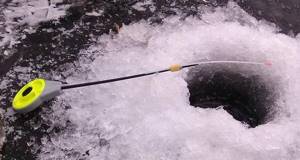
On the ponds
To fish in such reservoirs, you need to know its features, bottom topography, silt layer, presence of vegetation and other types of fish. It often happens that in those places where crucian carp hibernate, on the first ice it can be actively caught before wintering, and vice versa, where it feeds all season, at the beginning of winter it may not show any signs of life at all.
In most ponds, some crucian carp are actively looking for food in small schools, while another part, larger in size, stands in pits. In small bodies of water it is better to look for them rather than try to feed them. As a last resort, throw a small pinch of bloodworms into the hole. It’s better to drill in a checkerboard pattern from shallow to deep, this way you’ll quickly find a school or camp in a hole.
Fishing for crucian carp is a constant search for promising places, bait and groundbait, especially if this place has never been visited before. There are no specific fishing rules for any body of water.
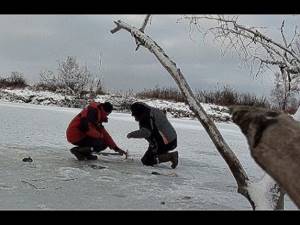
Active and passive tactics
There are two types of tactics: active and passive. It is selected depending on the specific hunting conditions and fish behavior:
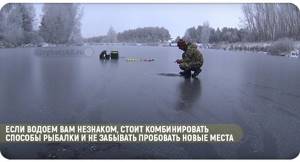
- A quick search, which involves developing the territory in order to identify a flock constantly moving around the reservoir. First of all, you need to drill holes in increments of 50–100 m, and then break out a square of holes in increments of 10–20 m. This method is more suitable for fishing in large water areas.
- A targeted survey of a body of water where staggered tactics are applicable. They begin development from shallow areas and move on to deep ones. This method is relevant for small bodies of water and fishing on canals.
- Pointwise, when holes are drilled along the external contours of small rivers.
- Passive tactics, where 2-3 groups of holes are drilled and they are fed. Catching is so effective with constant migration of crucian carp; if it is not active, then there will be no result.
- Semi-active fishing, most often used in unfamiliar areas. A square of holes is divided in increments of 10–20 m; you need to wait 20 minutes on each hole, and only then move on to the next one. Here you need to be patient, the method works for passive fish and when it walks, covering a fairly large area. Usually, after catching two or three fish, it is recommended to start working with another hole. There are times when a couple more crucian carp can be caught by drilling a hole 1–2 m from the previous one.
For greater convenience and efficiency, it is worth using 3-4 fishing rods at a time, per stand. They are visible and not so difficult to observe. The optimal step between them is 1–3 m. Instead of floats, it is better to use nods, they are easier to control.
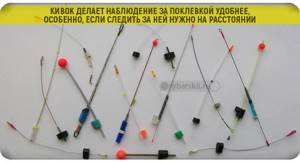
Reservoirs and lakes
On the first ice you should do everything almost the same as on ponds. It’s better to focus on an active search, but you also need to check the holes and flooded snags. You have to constantly move and search along the coastline or on uneven bottoms. To collect actively feeding fish, you can use bait, preferably dark in color, matching the color of the bottom and without unnecessary odors. A semi-active fishing method, when holes are drilled 10–20 meters apart, is the most promising tactic on the first ice. You don’t need to do a lot of them, spend 20 minutes on each one and, if there are no results, move on and do new ones.
Sometimes the crucian carp stands scattered at a great distance, in this case this tactic will also work, the bite will take place little by little, 2 - 3 individuals, then it’s worth moving to the next place and trying again, but in this case there will not always be a transition to long distances, sometimes A couple of meters is enough. Types of winter gear.
Winter gear
The main equipment for winter fishing for crucian carp is the usual summer float equipment, as well as a winter fishing rod equipped with a reel, nod, line and jig. Some fishermen make equipment for crucian carp with their own hands, others buy it in a store. Winter tackle for a float fishing rod can be wound on a special reel or reel. Next, we take the bait, put it on the hook, lower the bait to the bottom and wait for a bite. If there is no crucian bite, then you can attract fish by moving the bait.
Selection of equipment
The pickiness of crucian carp applies not only to the selection of bait and groundbait. The selection of equipment is also important. When going fishing, you need to take different equipped fishing rods with you (different jigs or hooks, their landing height, fishing line thickness).
During the period of the first ice and before its disappearance in the spring, feeding occurs very actively, and the fish loses its vigilance. At this time, large lures, jigs and baits are used; the thickness of the fishing line will also not cause problems.
In the middle of winter, it is necessary to select thinner gear due to the clarity of the water and the wariness of the fish, but at the same time they must be strong enough. It is better to take fluorocarbon, it survives very well constant friction with ice, which cannot be avoided during winter fishing.
Often they use homemade tackle, which is similar in design to a girder, only much simpler. In its appearance it resembles a cross (that’s what it’s called). The cross itself is located on the hole, clinging to the edges with two ends of a piece of wood; from it, a fishing line with a weight and a hook goes into the water, tied to one of the ends of the cross, which hangs over the hole.
When biting, the entire structure rotates, the end with the fishing line goes into the water, and the opposite one rises up, indicating the catch. This is a passive tackle, so you can install a lot of them, periodically checking and changing the bait.
You can fish with standard winter fishing rods with nods, or with a float.
Float equipment
For it you will need a standard winter fishing rod, fishing line with a thickness of 0.1 - 0.2 mm. To increase the chances of a catch, you can tie a heavy jig to the end of the fishing line and a light jig on top, or just a hook. You can attach it either to a leash or to the main fishing line. The fact is that crucian carp can take bait both from the bottom and from a certain distance from it (10 - 15 cm to start with, but most likely you will have to experiment).
After each bite, the bait must be changed; the crucian carp will not take it a second time. After it disappears, it’s generally better to change it for something else, since the cautious fish won’t try it next time.
When fishing this way, the float must be under water, so it will not freeze, at a depth of up to 5 cm below the water line. Its color should be bright, clearly visible in dark water. The appearance of the bite may vary. The crucian carp can suddenly drag the bait away, or it can slightly test it at first, while the float will jerk upward. This kind of fishing is only suitable for reservoirs without any current at all. Fishing with a nod.
When fishing this way, it is necessary to pay very serious attention to the correct loading of the nod. With it, neat bites are very clearly visible. In the middle of winter, crucian carp becomes more lethargic and bites inactively, often throwing the bait if it feels its weight and the slightest resistance.
This is why a properly configured, flexible nod is so important. Both waiting tactics and active play are suitable. In this case, you can sharply lower the bait directly to the bottom to lift the silt from the bottom and slowly raise the hook to a height of 15 cm.
For a successful fishing outcome, it is worth taking with you both types of equipment, with different numbers of hooks and jigs, adjusted to different depths. Drill several holes and throw the bait approximately in the middle so that it works on everything at once. Place fishing rods in them and check which one will get the best bites; this method will significantly reduce the time for selecting the right equipment. Bottom gear.
Such equipment is chosen when fishing on rivers, since their fishing is much stronger, and the fish here are not so careful, so rough execution will not scare them.
One of the most common equipment is the “yoke”. This structure consists of a sinker through which a wire is passed, at the ends of which two short leashes (5 - 7 cm) with hooks are tied. You can attach both the same and different baits, which will speed up the selection of the more suitable one.
The choice may also fall on other species suitable for a certain type of river. Instead of weights, you can use small feeders; the main thing is the correct selection of bait and, when fishing on the river, its consistency.
In the southern regions, where reservoirs are often uncovered from ice during the winter, and some are not covered with it at all, a feeder is actively used. When using it, the selection of baits differs from the choice for other winter gear. The fact is that when casting, most standard winter baits (dough, bread, etc.) will fall off the hook either when flying or when they hit the water.
Lure
Fishermen intensively use the following components as bait mixtures for crucian carp:
- Ground or breadcrumbs;
- Halva, crushed sunflower seeds or cake;
- Rye bread;
- Barley porridge, as well as millet, oatmeal, barley or pearl barley.
The presented bait components can be used separately or by mixing several components. In addition to them, you can add to the bait:
- Flavoring essential oils;
- Honey;
- Yoghurts;
- Baby food;
- Egg powder.
These additives will additionally give your bait taste and aroma qualities. Which will have a positive effect on the activity of crucian carp. In winter, animal components are often added to plant food; as a rule, this is the bait on which fish will be caught.
Ride
The gear is intended for fishing on rivers. In general, you can catch any white fish with it, not just crucian carp. Choose familiar, deep places.
The equipment used is rough and durable. The reel must be voluminous, since fishing is carried out at great depths. A thick fishing line is selected in length for a specific fishing spot, a sliding weight weighing up to 20 grams is threaded into it, and at the end its movement is limited by a stop bead. Below it you can attach a swivel, and to it a leash with a hook, or you can also attach it to the main fishing line.
Pokatka is a passive tackle, so you can install several fishing rods at once, while the bait must be thrown upstream.
A gear very similar to this is called a descender (“harvester”). Also used in currents. There are many types of installation. The equipment, as in the previous version, will require strong equipment. Instead of a load, you can use a feeder, a sliding or tightly tied load. It looks very similar to a feeder; more often than not, several hooks on leashes are used; they can be installed below the load or both above and below it.
When playing, the fish must be carefully pulled out both from the water and from the hole. Since in a current, even small individuals exhibit strong resistance, mainly due to the force of the current. Jigs.
What do crucian carp bite on in the first ice?
In the first ice conditions, baits of plant origin are ineffective. During this period, it is better to give preference to the following baits, which work flawlessly for crucian carp:
- bloodworm;
- muckworm;
- burdock moth larva;
- maggot;
- Sandwiches made from bloodworms and maggots.

If the bite is passive, then small hooks or jigs should be used in tandem with bloodworms. Maggot or semolina will help save the situation when ruff and small roach are present in the fishing area. The main principle in successful fishing is fresh bait with an attractive smell.
Necessary baits
As in the case of bait and bait, here it is also necessary to constantly select the desired option; during the day there may be several changes in preferences. It is better to have with you a full set of all kinds of baits (“pellet”, “drop”, “devil”, “goat”, “uralka”, “lentil”, “boat”, “barrel”, “bug”, “ant”, “ oatmeal").
During the freeze-up period and before the arrival of spring, when crucian carp begins to become active, it may give preference to larger and coarser baits. And in the middle of winter, small baits and strong thin fishing line, preferably fluorocarbon, work better. Tungsten jigs are very suitable in this case; they are small and also, due to the properties of the metal, quite heavy. When fishing at night, you can use phosphorus jigs.
In general, options that are simpler in shape and color (black, silver, gold droplets and pellets) perform better. The difference is in depth, the greater it is, the brighter the jig should be; in light weather, darker ones work better. The game, as well as the bait, must be constantly alternated, using both an active jig and a jig hanging motionless or lying on the bottom.
It has been noted that the optimal angle of the hook soldered into the jig is 35-40 degrees. It must be small and durable.
A rod for jig fishing is usually 40-45 cm with a soft tip.
If there are no bites for a long time, then you need to raise the jig to the very top and smoothly lower it to the bottom, simulating a free fall of the bait. Fishing should be done slowly and very smoothly, so as not to tear the lip of the crucian carp. Pull it out of the hole with your hands by the gills; the fishing line used is very thin and can break. It requires special care; it must be cleared of frozen ice, just like the hole, so that there are no snags or cuts.
It is better to cover holes drilled nearby and not used as unnecessary, as the light from them will frighten and distract the crucian carp.
Fishing for crucian carp on the first ice
Every time I go for crucian carp, I am surprised at what an unusual fish it is. Not just unusual, but unpredictable. In some reservoirs, crucian carp actively feeds throughout the entire period of open water. In other reservoirs, this fish bites exclusively in the spring and extremely poorly in the summer and autumn. In third bodies of water, crucian carp take bait well all year round.
And there are also lakes where crucian carp are most active on the first ice. For example, I know several reservoirs in which only goldfish live and they are caught for several days in early May and in the first couple of weeks after the ice is installed.
It is also very interesting that in some reservoirs crucian carp is caught from the ice during the day, while in others only at night. Usually, where crucian carp bite in the light, it does not respond to bait, and sometimes even leaves the baited place completely. “Nocturnal” crucian carp usually have a positive attitude towards bait.
Moreover, bloodworms and other insects work well as bait, but there are lakes in which the best bait is either cake or highly diluted winter bait. The amount of bait should be small - one or two balls, since the bait is intended only to stimulate the crucian carp to bite, and not to activate it.
One of the most important components in successfully catching crucian carp from under the ice is the choice of location. Crucian carp, starting in the fall, when the water cools, gathers in the deepest holes, but after the ice forms, the school may disperse. Most of the crucian carp herd remains near the pit, and some leave the depths and go to snags. These fish are the most active and can feed throughout the winter.
It has also been noted that throughout the winter, crucian carp are caught only in those reservoirs that are flowing and have a constant flow of fresh, oxygenated water. That is, these are reservoirs formed with the help of dams or dams.
The water level also plays a big role. It is known for certain that in summer a decrease in water level leads to a cessation or significant deterioration in the bite of crucian carp and crucian carp. In winter, on the first ice and during thaws, a decrease in water level, on the contrary, leads to increased bite. The fish leave their winter camps and begin to move around the reservoir in search of food. If the water falls before freeze-up, then the crucian carp feeds after the ice freezes also due to the lack of coastal food supply.
Read: Catching chebak from ice
Fishing for crucian carp in rivers can be very good. For example, in the upper reaches of some slow-flowing rivers, crucian carp is caught throughout the year. In such places in summer, crucian carp can often be caught at a bend in the riverbed, below riffles or shallows.
In winter, crucian carp prefers to stay near the steep shore, in large tree roots. Less often, crucian carp can be found in a pit with a reverse flow in winter.
To choose a fishing spot in still water, sunken snags will be a good guide, which you need to discover and remember while still in open water. It is known that the hole closest to the tree trunk is often the most catchy hole. This has its own inconvenience, since crucian carp actively resists even in winter and it costs nothing for it to tangle the tackle with snags at the bottom of the reservoir. But it's worth the risk. Because even half a meter from the tree, sometimes you may not get a bite at all.
Knowing several catchable places on the lake near snags, you can fish well around them not only in winter, but throughout the year.
But it’s not only near flooded trees that you can find a school of fish. On all bodies of water there are places, or rather points, that crucian carp especially like. And not only do they like it, but here the crucian carp feeds and remains active all winter. It is not possible to identify such places by any signs; they are discovered mostly by chance during fishing.
Such points need to be remembered either by landmarks on the shore, or even better, using a GPS navigator. A good navigator gives an error in determining the coordinates of a point of less than a meter, and a very good one - several centimeters.
It is important not only to know the body of water, but also to know at what time of day you should count on luck. It makes sense to make holes in advance when crucian carp reacts to one or another bait, that is, during the hunt for night crucian carp.
The tactics for catching daytime crucian carp are very simple, one might say, unpretentious. To do this, you do not need to drill hole after hole, as happens when searching for perch, pike perch or bream. You need to drill several holes in previously known feeding areas for crucian carp and methodically check them. During such fishing, you should not rush and change holes earlier than ten to twenty minutes.
Read: Recipes for the best baits for crucian carp
During this time, you need to try out not only different gear options, but also different ways of playing with bait. In any case, you should not use tempo tactics of play and changing holes. Crucian carp is not perch. The tactics of catching crucian carp are most similar to the tactics of catching roach in the middle of nowhere. Both in the search pattern and in the playing technique.
The tactics for catching night crucian carp are closest to the tactics for catching the same roach and bream.
Since the behavior of crucian carp in literally every body of water is unique, it is not possible to give any definite and specific recommendations on gear and fishing techniques. The best thing is to visit the chosen reservoir, talk to the elders, see what and how they fish, and find out the results of previous fishing trips.
It is very important to pay attention to the following points:
- exact size and configuration of the bait;
- line thickness, hook size, sinker placement, float capacity;
- size of bait or attachment;
- how the angler regulates the descent, that is, at what level the bait and load are located;
- playing techniques and techniques;
- frequency of checking and changing bait;
- time at which bites were observed;
- what and how the fisherman feeds and with what frequency;
- how often and why the angler changes the fishing point.
It is important to understand the semantic logic of the entire set of actions of the fisherman.
Here I would like to draw attention to the fact that gear for catching crucian carp can be very different and even unexpected.
To catch night crucian carp you will almost always need a winter float rod. Night crucian carp searches at the bottom for either bloodworms or remains of vegetation. Insect larvae and worms do not show much activity, so the crucian carp looks for easily accessible food lying on the bottom or in the mud. The use of float equipment does not imply the use of any kind of bait play.
The descent is measured in such a way that the hook with the bait lies at the bottom, and the catch is at a distance of three to twenty centimeters. The following is important. The steeper the slope of the bottom under the hole, the smaller the distance between the underlayment and the hook should be. If the bottom is flat, and therefore silted, then there is no point in making the distance less than twenty centimeters. Moreover, it makes sense to increase this distance to a meter. I'll explain why.
Read: Catching crucian carp from ice on a pond
Experienced bream fishermen use the following technique during periods of very weak bream biting in winter. They make a leash about a meter long and every few minutes they sharply raise the equipment and sharply lower it. In this case, the leash with a light bait on the hook bends in a wave-like manner and the bait is placed at another point on the bait. Using this technique when fishing for crucian carp makes complete sense.
When catching daytime crucian carp, three equipment is used. The first is the same float, with a hook No. 18 and a bloodworm. The second equipment is the “devil”.
There is no point in talking in detail about what a “devil” is now; it makes sense to focus on which “devils” are preferable. Practice shows that two options are most effective. Or using one decent-sized lead devil, despite the fact that the fishing depth can be only two to three meters. Or use a rig of two little devils, that is, a “locomotive”. Depending on the size of the fish, and therefore the diameter of the fishing line, the “devils” in the “locomotive” can be either lead or tungsten.
Sometimes good results are achieved by replacing the bottom “devil” in the locomotive with a black “nymph” or even a fly. The fly is crocheted on a hook No. 14-18 from regular black thread.
The choice between large and smaller bait is based solely on the tastes of the crucian carp in a given body of water. It happens that the worker turns out to be a “devil” three centimeters long. It is not worth putting bloodworms or maggots on the “devil” hooks, as is often done when fishing for bream.
It is very important to choose the game of bait. The most effective game is to slowly raise the bait to a height of about half a meter from the bottom. Moving the bait directly at the bottom, with periodic touches, gives good results. It has been noticed that crucian carp in winter reacts well to smooth, but wide and rhythmic vibrations of the bait.
In some reservoirs where there are really large crucian carp (a kilogram or more), it is possible to catch them even with a spoon. The game is very unique. It consists of slowly moving on the ground, very slowly raising the bait and slowly lowering it. Often, crucian carp takes such bait only after it freezes.
Mothless
This species performs well with a more active search for food for crucian carp (on the first ice and by spring). You should start with small and darker options and gradually try others if the first ones are not suitable, since there are no special ones for crucian carp.
When fishing with a reelless bait, no bait is used, so the fish must be attracted by the game. It should be neat and smooth with periodic pauses, hovering a few centimeters above the bottom and lowering into the silt to raise the turbidity.
The fish will take the bait very carefully and smoothly, so the main thing is not to miss the bite and hook it in time, otherwise the crucian carp will simply spit out the hook.
Catching crucian carp on the first ice is not such an easy task, but with the right approach it will bring a lot of emotions. If you liked the article, share your opinion in the comments.
Bait
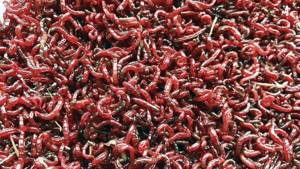
The main baits for catching crucian carp are the following:
- bloodworm;
- maggot;
- worm;
- semolina chatter;
- dough.
Bloodworms take precedence as bait for crucian carp, but sometimes other types of baits can be more effective.
